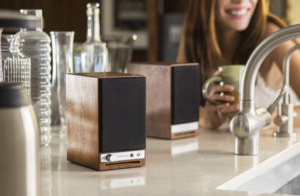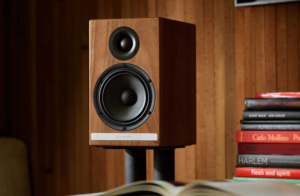Your cart is currently empty!
When I reviewed Audioengine’s flagship HD6 speakers a few years back, I was absolutely smitten with their build quality and magnificent sound—especially with a hardwired connection to a good source. I so went on about the sound quality—finding it not at all unlike that of a good British mini-monitor—that, after the review, Brady Bargenquast of Audioengine told me he felt that I was somewhat missing the point. His point being, how great the HD6 sounded wirelessly—which was one of their most important selling points. Hmmm…despite the fact that I still stand by my claims for the HD6’s superlative sound quality via a wired connection—maybe I needed to re-evaluate my process going forward, should the opportunity ever present itself again.



Fortunately, it did, and has—on multiple occasions, and guess what? Brady was right. I have since gone the extra mile by fully evaluating the wireless capabilities of both the HD3 and A5+ powered loudspeakers. Finding them both to be shining examples of the current state of Bluetooth and aptX wireless audio technology, as well as sounding musically magnificent, playing at a level far beyond their respective (and surprisingly meager) price points. And now I have the new A2+ Wireless powered speakers in for review, and you’ll never guess—they’re pretty freaking fabulous as well!
Brady and I got off on entirely the wrong foot with the lead-up to the review pair of A2+ being shipped to me. His email offering them was the first thing I looked at that morning—I hadn’t even tasted my coffee yet. A section of his email read: “In addition to our extended-range Bluetooth aptX, another feature worth mentioning is that we’re still using all-analog, class A/B amplifiers, where most speakers in this size and price range have digital amps. These new amps sound pretty good but just don’t have the warmth of our old-school analog designs.” Now, having since re-read this email a half-dozen times, I understand with absolute clarity what Brady was saying. But on that morning, the only thing that registered in my still half-asleep brain was “These new amps just don’t have the warmth of our old-school analog designs.” How could their new amps not sounding as good as their older designs possibly be a selling point for the A2+?
I quickly fired off an email to Brady, questioning the design rationale; why mess with an already great thing? He was already working and responded in his usual, extra-professional manner that perhaps he should have worded the description differently. Audioengine is still using their tried-and-true Class A/B amplifier designs, not the inferior digital amp designs found on some competing products. I immediately re-read the original blurb several times, totally realizing my complete idiocy and lack of comprehension. I promptly issued an apologetic response—embarrassingly promising not to read any more emails until I’d at least drunk my first cup of coffee. Sheesh!
Upon arrival and unboxing, I was pumped to see that Brady had sent the review pair in the ultra-sleek, high-gloss red finish. If nothing else, they are incredibly beautiful to look at. Beth, uncharacteristically unrestrained, also offered an exclamatory “Wow! Those are pretty! I might let you leave those upstairs!” So all listening has been done in our large living room/dining/room/kitchen area, which measures roughly 26 feet x 30 feet with a 14-foot vaulted ceiling. I was a bit concerned that the diminutive A2+ wouldn’t be able to fill that rather voluminous space effectively; no worries—never at any point did I ever feel they fell short of delivering superbly room-filling sound. That space is over 8,300 cubic feet; way more than double the size of my dedicated listening room. And I was a bit concerned how the A2+ would respond down there. I guess the correct response would be magnificently!
Each A2+ measures 6″ (H) x 4″ (W) x 5.25″ (D); the pair weighs just under seven pounds, though the left speaker is slightly heavier—it contains all the electronics. Each unit contains a 2.75-inch aramid fiber woofer, with a three-quarter inch silk dome tweeter. There’s a narrow slot on the front panel at the base of the enclosure that serves to port the enclosure and extend the bass response down to 65Hz—quite remarkable for such a tiny woofer and small enclosure. The silk dome tweeter extends the treble response to 22kHz. Each channel is rated for 15 watts RMS/30 watts peak, for a combined total of 60 watts peak output, all in monolithic Class A/B. With a signal-to-noise ratio of 95dB. After just letting them play for several days intermittently to break them in, I pretty much then put them through their paces—never at any point did the sound seem strained or forced, and was totally distortionless, even at maximum volume.
As with all Audioengine powered speakers, the rear-panel connection choices are pretty much comprehensive. With both RCA inputs and outputs (great for adding an Audioengine sub, you bassheads!), a standard 3.5mm audio input jack, and a micro-USB input. Audioengine also supplies the needed cables to make any hardwired connections, and they also supply an “umbilical” cable to connect the two speakers to each other. All the cables and connectors are of the highest quality and appear to be heavily plated; the one exception was the speaker cable, which I felt was surprisingly (and uncharacteristically) lightweight. But considering the wattage requirements of the A2+ system, it’s most likely more than sufficient for anyone’s needs—I never at any point felt it was a liability—and you can always roll your own.
A laptop-like power transformer setup is supplied—most likely because there’s precious little space inside the cabinet for a transformer. While I did test all inputs to confirm that they worked satisfactorily, I dispensed with my usual practice of mostly using hardwired connections for the majority of my listening. Most purchasers of these speakers will doubtless generally use a Bluetooth connection, and I’m now more than satisfied that the current state of the Bluetooth art gives you superb performance. And there is no aspect of the performance of these microscopic babies that fall short of superb. By the way, I did observe one notable absence from the rear panel—no Bluetooth antenna or connection for one was present. I guess this newest generation of Bluetooth technology is really robust!
At the dining room end of our living space, there’s a 1960s Danish hutch; the lower half’s shelf extends about six inches beyond the upper display portion. That shelf provided the perfect spot to place the A2+; I placed them flush with the front edge, and that extended them to about a foot beyond the back wall, and about five feet apart. Though not centered in the overall room, that setup offered an exceptionally good musical portrayal, with good imaging and an excellent tonal balance. This setup also offered the added benefit of placing the tweeters very close to ear level for everyone seated in the living room. Audioengine powered speakers all have a rubberized pad on the base of the speaker that provides the perfect amount of isolation and vibration damping so that the speakers don’t impose much of their character on whatever furniture they’re placed upon. And besides all the technical niceties, they do happen to look really good sitting there!
While I’ve always been impressed with the overall neutral character of any of the Audioengine products I’ve had the pleasure to evaluate, I found the A2+ pair deviated slightly from that neutrality with a slight presence boost in the midrange. This was especially noticeable with recordings that highlighted female vocals, and for me was a most welcome addition. These are very small speakers that manage to offer stunningly lifelike portrayals of a variety of musical genres, and the slight boost in the midrange presence gives them a touch more you-are-there realism. Very unexpected in such a diminutive speaker of such modest wattage.
The aesthetic fits my new home perfectly; it’s a 50s/60s themed mid-century modern, so the low-but-high-quality wattage powering highly efficient (while modestly proportioned) enclosures are a match made in heaven. If I were planning on living with these for any sustained length of time, I’d probably want to add the Audioengine subwoofer—I actually prefer a bit more bass response. But for ninety percent of my listening needs, the A2+ are surprisingly satisfying. And while I expected them to behave badly when pushed too hard, the opposite was true; they never distorted, became chesty, or took on a one-note quality.
I listened to a ton of music during the evaluation period, ranging from classical, vocals, jazz combos, and 90’s metal like Soundgarden. I just picked up a copy of the Badmotorfinger CD; I’m at that point where I’m filling in holes in my music server, so picking up a disc I personally have little or no experience with is a no-brainer for typically a buck a pop. The opening track, “Rusty Cage,” was delivered with a surprising punch from the A2+ pair. Just place your hand near the slots on the front of each unit—they’re moving tons of air on material with lots of bass content.
I’m a big fan of the Australian band The Church; I stumbled across a very rare Australian pressing of their 1996 release Magician Among the Spirits, which is virtually (and criminally) unknown here in the states. The title track is this fourteen-minute, psychedelic dirge of a vamp where Steve Kilbey’s bass just powers along, while Peter Koppes and Marty Wilson-Piper add sultry-sweet guitar fills throughout. It’s the greatest song I’d never heard before a couple of months ago. And the A2+ delivers it with surprising accuracy and punch—they always seem to have something left in the tank, even for the most demanding performances. Just remarkable.
I recently ordered a CD copy of The Cramps classic Psychedelic Jungle. Even though there’s no bass player on the first few Cramps albums, drummer Nick Knox literally hammers away at his kit while Poison Ivy adds the heavy guitar licks, providing the perfect underpinning to Lux Interior’s proto-screams throughout. They don’t call it Psychobilly for nothin’, you know. Anyway, the A2+ offered up the cacophony pretty much unvarnished—no mean feat for such tiny wonders! Songs like “Goo Goo Muck” and “Voodoo Idol” were delivered with surprising precision.
Everything I hurled at the A2+ was rendered with impressive fidelity, whether Dave Brubeck, Miles, Coltrane, or Bill Evans. Even large-scale orchestral music fared remarkably well; I’ve got a series of recent recordings on the Chandos label that features John Wilson, a British conductor leading one of the BBC orchestras. They’re playing the music of Aaron Copland, and it’s maybe the most idiomatic renditions of Copland’s orchestral music I’ve ever heard. These outstanding recordings have most definitely become my go-to demonstration discs for the big system downstairs. This is sweeping, grand, powerful music that portrays the America of our dreams, an America of peace, love, and inclusion. The suite from “Billy the Kid” will test any system, bar none—and the little A2+ acquits itself remarkably well, though you definitely need a sub to get the whole picture.
My acid test is, of course, Kor, the Proprius disc featuring the Mikaeli Chamber Choir. Definitely one of my desert island discs, it features music that ranges from sacred to the profane; some of the pieces feature organ accompaniment that will plumb the depths of your system’s capabilities. Because the disc features such huge dynamic swings, it was intentionally recorded at a much lower level to highlight the impressive range of the performances. So I had two concerns: would the A2+ be able to manage the organ and massed voices without distorting; and would they be able to offer enough volume to provide a satisfying listening experience for this demanding music? Once again, no worries: the A2+ offered superb realism that defied belief—how can this massive sound be coming from these really tiny drivers and enclosures? And again, even with the volume setting maxed out, not a trace of distortion, and never once was any hardness or unpleasantness evident in playback.
Most of my music choices were streamed wirelessly from either my laptop (via Roon or JRiver Media Center, using my cell phone as the endpoint), or directly from my cell phone (Tidal and Qobuz accounts). So for all of my wireless streams, the 16-bit, 48KHz internal DAC of the A2+ was employed. Not audiophile in the truest sense of the word, but with sound this good from such a small source—who’s quibbling over nits? When connected directly to my laptop—which would probably be the case in most desktop situations—I had my AudioQuest DragonFly Red inserted with a connection to the back panel 3.5mm audio input, so the internal DAC of the A2+ was bypassed. The 24/96 sound coming from the DragonFly through Roon was a definite uptick in terms of sound quality.
I’m totally sold on the A2+. At this ridiculously low price point, there’s absolutely no reason why they shouldn’t be sitting at every music lover’s desktop, or in a whole lot of dorm rooms across the country. They acquitted themselves so very nicely in a relatively large room—it only reasons to think that they’d really sing and provide a seriously satisfying listening experience in a much more typically sized environment. And even though they weren’t ideally placed in the room, they filled the room with remarkably good sound that defied localization—exactly what you’d expect from any pair of speakers with audiophile pretensions. For $269, you generally expect to get junk, not something that truly offers a generous taste of the audiophile experience. Very highly recommended!
Read the full review here.












